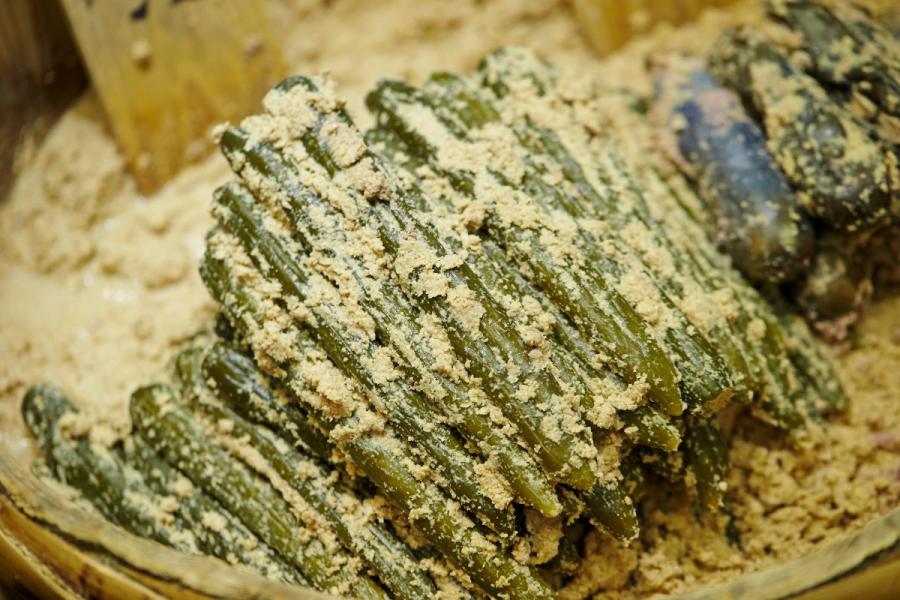Nukazuke
Discover the art of nukazuke, teh traditional Japanese rice bran pickling for flavorful and nutritious delight.
Nukazuke is a traditional Japanese pickling method that uses a fermented rice bran (nuka) bed to pickle various vegetables and sometimes fish. The nuka bed is a mixture of rice bran, salt, and other ingredients such as kombu (kelp), dried fish, and various aromatics. The mixture is fermented, creating a unique environment teeming with beneficial bacteria, which helps preserve the food and give it a distinctive tangy, salty, and slightly sour flavor.
Vegetables or fish are buried in the nuka bed and left to ferment for varying lengths of time, from a few hours to several days or even weeks, depending on the desired flavor and texture. Some common vegetables used for nukazuke pickling include cucumbers, radishes, eggplants, and cabbage.
Nukazuke pickles are an important part of Japanese cuisine and are often served as a side dish, snack, or accompaniment to rice. The nuka bed itself requires regular maintenance, including turning and occasionally refreshing the ingredients, to keep it in optimal condition for pickling.
Nukazuke is a unique and versatile pickling method that has been a part of Japanese food culture for centuries. It is believed to have originated during the Muromachi period (1336-1573) in Japan. Over time, nukazuke has become an integral part of the Japanese diet, and the practice of making and maintaining the nuka bed has been passed down through generations in many households.
The nuka bed is a living ecosystem of beneficial microorganisms, including lactic acid bacteria and yeast, which contribute to the fermentation process. These microorganisms help break down the natural sugars in the vegetables and convert them into lactic acid, which acts as a natural preservative and imparts the characteristic tangy flavor to the pickles.
To make a nuka bed, rice bran is mixed with water, salt, and other optional ingredients such as sugar, miso, or beer. The mixture is then allowed to ferment at room temperature for several days, during which the beneficial microorganisms multiply, and the nuka bed matures. It's important to aerate the nuka bed daily by stirring it to ensure even fermentation and to prevent the growth of harmful bacteria.
Once the nuka bed is ready, vegetables or fish can be added to it for pickling. Before being placed in the nuka bed, the vegetables should be washed and dried thoroughly, and any leaves or stems should be removed. The length of time required for pickling depends on the type of vegetable and the desired level of fermentation. For example, cucumbers may only need a few hours, while daikon radishes might require several days.
Nukazuke pickles are highly nutritious, as the fermentation process enhances their vitamin and mineral content, and the lactic acid bacteria present in the nuka bed also contribute to gut health by promoting the growth of beneficial gut flora. Moreover, nukazuke pickles have a long shelf life, making them a practical and delicious way to preserve seasonal vegetables for year-round enjoyment.
In recent years, nukazuke has gained international attention, and the unique flavors and health benefits of these fermented pickles have led to their growing popularity in global cuisine. Some Japanese restaurants outside of Japan have also started offering nukazuke as a traditional side dish or appetizer.
You can buy pre-made nuka beds or nuka bed starter kits, which can save you time and effort in preparing and fermenting the rice bran mixture. These products are available at some Japanese grocery stores or specialty food shops, as well as online retailers.
When purchasing a pre-made nuka bed or a starter kit, be sure to read the instructions and ingredient list, as some may require additional ingredients or specific care instructions. Also, check the expiration date to ensure that the product is fresh and suitable for use.
Keep in mind that even with a pre-made nuka bed, you will still need to maintain it regularly by stirring and occasionally refreshing the mixture. Once you have your nuka bed, follow the same pickling process as you would with a homemade one, and enjoy the delicious and nutritious pickles it produces.

